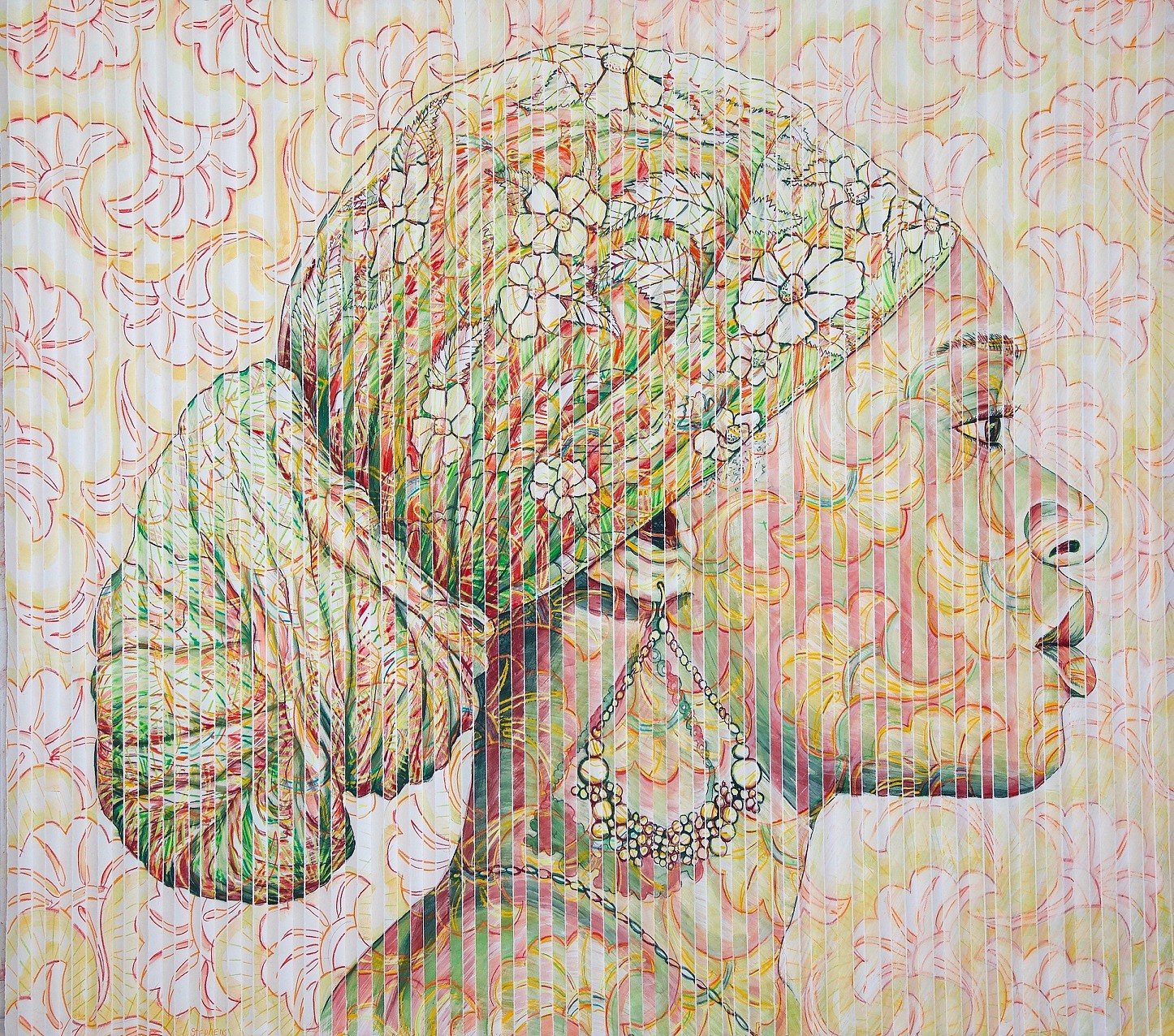PRESS RELEASE

GARY STEPHENS: Pleated
Jun 1 – Jun 24, 2017
GARY STEPHENS
PLEATED
1 – 24 JUNE 2017
Gary Stephens’ new drawings combine African fabric designs with portraiture allowing for the patterns to randomly break through and add a delicate decorative element to his figures. Still focused on the iconic African symbols of women in head scarves, hat culture for men, Stephens explores colour. As the viewer moves in front of the works, the colours shift, causing the figures to change from red to green when viewed from side to side. His meticulous technic of drawing in vertical stripes and pleating the paper give the images a subtle visual vibration and vitality. In addition to this, he creates systems of hand dyed strings, installed in front of the works that cast a warm tone on the images and a sense of motion as the viewer moves in front of the piece. In this new series Stephens continues his experiments in drawing figures that are not solid but full off light and a sense of movement.
The medium is chalk pastel which is normally used in sticks for drawing, but Stephens has also ground the pastels and diluted with water to paint thin washes. The effect allows the patterns which are drawn underneath the figures to resist the transparent washes and remain visible. In some cases, white acrylic gesso is painted on to create contrast in the backgrounds and separate the figures. The fabric patterns and loosely painted washes vitalize the new portraits.
The Floating Jozi Hat is an interactive selfie-installation that pays homage to the style and flair of hat-culture in Johannesburg. Worn at just the right angle, height, rim positioning and tilt, this celebration of hats continues Stephens’ ongoing appreciation of urban-African style. The piece features the artist’s collection of cloth ‘bucket-hats’; juxtaposing the hat’s journey from being bargained for on the streets of the CBD and thereafter brought into a gallery context. Viewers are invited to play amongst the suspended ‘raining’ hats of vivid colour, ‘trendy’ African prints, plaids and floral patterns and encouraged to take a selfie under their favourite style. By drawing the viewer’s attention to hat culture, Stephens hopes for people to take time to notice and celebrate this iconic fashion statement from everyday Johannesburg life.
The Angelina portraits are a series of photographic portraits that draw on well-loved fabric panel designs with a variety of names across the African continent. The pattern, which originates from an embroidery neckline on a 19th century Ethiopian noblewoman’s tunic, was originally produced by the famous Dutch Wax Hollandais company Vlisco. The popularity of the print coincided with the release of the hit radio song "Angelina" by Ghanaian band, The Sweet Talks. People loved the song so much they eventually began referring to the fabric of the same period as 'Angelina’. The name became so popular in West Africa that Vlisco uses it when referring to their iconic print.
In the DRC, Miriam Makeba was wearing the fabric when she performed in the 1970’s at a Kinshasa concert to celebrate the famous Mohamed Ali verses George Foreman boxing match. Due to the Congolese locals fondness of the singer, they started calling the fabric “Miriam Makeba” in her honour her. Other common names include “Addis Ababa”, “Mashallah”, and “dashiki print” which refers to the loose fitting men’s garment called a “dashiki”, most commonly made from Angelina fabric.
Stephens’ interest in the panels alludes to the cultural power that fabric has come to symbolise in African culture. Young South Africans are returning to wearing the print as a way of celebrating their African heritage and showing their sense of pride in their ancestry. Stephens’ new photographic series stands as a commemorative body of work; emphasising the fabric itself and its many colour schemes and design variations. The Angelina fabric has such a presence in everyday African life that the photos are meant to secure its place as an African cultural icon. Similarly to what Andy Warhol did in America with a coke bottle or soup cans with his historic repetitions’, Stephens tries to focus attention on the importance of this pattern in the greater African region.
All the fabrics in the photos were sourced from small fabric stores in the Johannesburg CBD area where small vendors offer a variety of colours and styles. Each framed section of the cloth is sold as a panel and refers to a complete section of the fabric design with its central emblem and rectangular border. By placing his models in the centre of the panels, Stephens creates a sort of fabric frame around the subject. The central emblem with its rays radiating out from behind their heads, transforms his youthful models into everyday African pop deities with their various scarf, hat and clothing styles.
Stephens works from his own photographs shot in strong light so that the high contrast images give his subjects a sense of being flooded in light. As in his previous work, Stephens’ new series strives to turn the people of everyday South African life into sublimely beautiful beings radiating a shimmering classical light. He strives to reflect back the sense of beauty he experiences in the people he meets living in South Africa.



